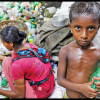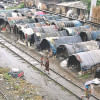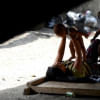Extreme poverty: Special measures or solved by growth?

In material development terms Bangladesh has changed a lot, and has made much progress since I first arrived just over 44 years ago. It has been a remarkable story of institutional innovation, significant globally as well as for millions of poor people in the country. The indicators of this progress are well known and herald a transition into middle income country status. Yet there remains significant, enduring poverty in the country, including extreme poverty. If we consider a broader category of vulnerability and insecurity, then well over half of the population could easily become poor again, given the risks faced by the country. There are two stand out observations from this scenario: first, that arrival at middle income status is being accompanied by increasing inequalities and frustrated aspirations; second, that poverty reduction so far is no guide to the difficulty of tackling remaining poverty, especially extreme poverty.
Two new books, launched in Dhaka on October 24, bring renewed attention to this difficulty. UPL has just published Aiding Resilience among the Extreme Poor in Bangladesh, edited by myself and colleagues from University of Bath, UK and BIDS. And in 2017, Practical Action Publishing produced Extreme Poverty, Growth and Inequality in Bangladesh again edited from Bath, BIDS and the Planning Commission.
The UPL book, based on original studies and careful fieldwork, starts from a shared premise that extreme poverty is significantly different from being moderately poor in the society, especially in terms of social isolation and exclusion from supportive networks of kin and social capital within communities, often reinforced by the prominence of female managed extreme poor households in a patriarchal society. It also challenges the "graduation" perspective (often only temporary) in favour of resilience goals when considering poverty reduction, and suggests that asset transfer approaches are unlikely to be effective on their own and need to be accompanied by social protection measures on the principle that increasing people's security encourages productive risk taking. But the challenge is how to mobilise and improve the capabilities of an inherently dispersed and diverse category of needy people?
While poverty is typically explained in terms of class inequalities and exploitative relations, extreme poverty is more idiosyncratically connected to the detailed circumstances of a household and its livelihoods trajectory. And any gains to those households arising from public policy initiatives need to be protected and sustained—this is the resilience question, pursued in the book through themes such as: targeting and threshold analysis; the challenge of protecting gains, especially using examples of land transfers; social protection, food insecurity and impact of cash transfers on the psychology of security and risk taking; implications for resilience of ill-health and disability; gender analysis of interventions and women's asset preferences; and a strategic assessment of community level and state interventions. Overall there is a prevailing argument that as Bangladesh approaches middle income status, there is need for an open debate about what kind of welfare regime is required to engage successfully with poverty, vulnerability and marginalisation. Such a debate represents the search for a new political settlement about the rights and duties between the haves and have-nots.
The second book comprises 10 strategic essays with authors from Bangladesh and the UK. It juxtaposes the "leave no-one behind" approach with a more re-distributive ambition, encapsulated in the phrase: "sharing the well", in order to improve poverty elasticity as a response to growth. "Leave no-one behind" is essentially a Pareto optimum or "trickle down" perspective, beloved by the neo-liberal west, which suggests that poverty eradication can be painless for the comfortable classes as it is solved by growth. "Sharing the well", by contrast, acknowledges the problem of growth with inequality and again argues that a deliberate political settlement is required in which the proceeds of growth are shared more fairly by redistributing the rewards to labour and citizenship. The book concludes by questioning that growth can absorb the growing labour force into those forms of employment which can adequately support secure livelihoods, and thus considers basic and citizens' income approaches, and their affordability in Bangladesh. To reach these conclusions, the book examines: extreme poverty trends, feminisation of poverty, financial exclusion, regional disparities, agricultural transformations and employment, urbanisation and new challenges for reforming the social security system.
Ongoing interrogation of the data draws attention to a wider set of actors beyond individuals and households, such as community level powerholders, other neighbours, local and remoter markets, and the state, who in combination can contribute to a household's resilience. This allows us to interpret resilience as not just about recovery to the status quo ante, but about sustained, more secure coping at an enhanced standard of living. This capability requires the anticipatory pre-empting of risk or hazards through preparation, as well as having a capacity to respond to shocks. Both aspects of resilience require successful relationships which are so essential to the socially isolated extreme poor.
If such relationships cannot be established, the pursuit of resilient livelihoods among the extreme poor becomes yet another unethical self-help fad, through placing the sole responsibility for action on the shoulders of the poor alone who are least able to bear it. A step beyond "business as usual" is thus required. Given that our data also indicate higher elements of idiosyncrasy in the explanation of being extreme poor, a three tier, interconnected policy levers framework is proposed to aid resilience among the extreme poor, and which engages with both systemic and idiosyncratic poverty in a blended approach:
- Addressing the strategic, meta context (such as climate change, prices of staple commodities, law and order offering security, rights of women and children, anti-discrimination of minorities, governance of state practices and market behaviour, tax compliance);
- Further development of meso level direct levers to support agency affected by systemic relations (asset transfers, social protection/safety nets, employment generation, education, microfinance, legally owned property, access to health services, protection of gains);
- And, as an innovation, micro-level engagement with idiosyncratic problems of families, almost like "social work" intervention, engaging with abnormal dependency ratios, learning difficulties, other disabilities, morbidity and other chronic weaknesses, desertion.
But we should accept two problems. First, if all meso level interventions are refracted through the meta level prism of inequality, rent-seeking, preferentialism, clientelism, gender and ethnic discrimination, backed up by violence, then in a sense there is huge wastage of effort and resource. Secondly, it has been surprising that the long acceptance of multi-dimensional poverty has not translated into multi-dimensional policy and practice as it affects poor people living in poor conditions. Poor people whose livelihoods depend upon informal support from kin, neighbours and patrons, find it almost impossible to connect to the remote, compartmentalised state, purportedly offering services and help. There is a social and cultural disconnect. To fit with this cognitive experience of dependency and restricted agency, they need an accountable, multi-sectoral, one-stop shop to replace their unaccountable informal patrons.
Governments therefore have to be persuaded that national level compartmentalised ministries exist to mobilise the expertise and resources to back up a structure of implementation on the ground, (i.e. "one stop shops" staffed by "poverty social workers"), which fits more accurately with the cognitive experience of poor citizens. In this way, the plea is for governments to organise themselves in ways which imitate the emic lives of the poor.
This third, micro-level, of engagement burrows down to much more personalised information about a family, entailing customised support. A powerful lesson from our data is that no two extreme poor families are alike in their trajectories, their composition and the challenges which they face. Thus extreme poor families cannot easily be reached through generic policy and practice. Insecure households require much more individualised support through the blend of assets transfers, social protection and overcoming social isolation. With its tradition of development innovation, can Bangladesh, as it approaches middle income status, again be a pioneer by adopting such a reform to its practices?
Geof Wood is Emeritus Professor, University of Bath, UK.

 For all latest news, follow The Daily Star's Google News channel.
For all latest news, follow The Daily Star's Google News channel. 







Comments